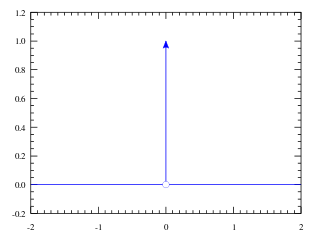Illustration of the method
The von Neumann method is based on the decomposition of the errors into Fourier series. To illustrate the procedure, consider the one-dimensional heat equation defined on the spatial interval , with the notation where are the specific x values, and are the sequence of t values.
We can discretize the heat equation [5] as
| 1 |
where
Then the solution of the discrete equation approximates the analytical solution of the PDE on the grid.
Define the round-off error as where is the solution of the discretized equation ( 1 ) that would be computed in the absence of round-off error, and is the numerical solution obtained in finite precision arithmetic. Since the exact solution must satisfy the discretized equation exactly, the error must also satisfy the discretized equation. [6] Here we assumed that satisfies the equation, too (this is only true in machine precision). Thus
| 2 |
is a recurrence relation for the error. Equations ( 1 ) and ( 2 ) show that both the error and the numerical solution have the same growth or decay behavior with respect to time. For linear differential equations with periodic boundary condition, the spatial variation of error may be expanded in a finite Fourier series with respect to , in the interval , as
| 3 |
where the wavenumber with and . The time dependence of the error is included by assuming that the amplitude of error is a function of time. Often the assumption is made that the error grows or decays exponentially with time, but this is not necessary for the stability analysis.
If the boundary condition is not periodic, then we may use the finite Fourier integral with respect to :
| 4 |
Since the difference equation for error is linear (the behavior of each term of the series is the same as series itself), it is enough to consider the growth of error of a typical term:
| 5a |
if a Fourier series is used or
| 5b |
if a Fourier integral is used.
As the Fourier series can be considered to be a special case of the Fourier integral, we will continue the development using the expressions for the Fourier integral.
The stability characteristics can be studied using just this form for the error with no loss in generality. To find out how error varies in steps of time, substitute equation ( 5b ) into equation ( 2 ), after noting that to yield (after simplification)
| 6 |
Introducing and using the identities equation ( 6 ) may be written as
| 7 |
Define the amplification factor
| 8 |
The necessary and sufficient condition for the error to remain bounded is that Thus, from equations ( 7 ) and ( 8 ), the condition for stability is given by
| 9 |
Note that the term is always positive. Thus, to satisfy Equation ( 9 ):
| 10 |
For the above condition to hold for all (and therefore all ). The highest value the sinusoidal term can take is 1 and for that particular choice if the upper threshold condition is satisfied, then so will be for all grid points, thus we have
| 11 |
Equation ( 11 ) gives the stability requirement for the FTCS scheme as applied to one-dimensional heat equation. It says that for a given , the allowed value of must be small enough to satisfy equation ( 10 ).
Similar analysis shows that a FTCS scheme for linear advection is unconditionally unstable.









































